The essential guide to diversity in nursing explains the lack of racial, ethnic, cultural, and gender diversity in nursing. Diversity in nursing means having nursing professionals who can represent the population they serve. The idea is a simple one, but right now, across the country, there’s a very serious need for diversity in nursing. This need is recognized by professional nursing organizations, hospitals, and others in the healthcare field.
But what does diversity in nursing actually mean? While many may think the term, diversity in nursing is a self-explanatory one, there are a number of facets that define what it entails and why it is important. No one simple diversity in nursing definition can encompass the enormity of the term.
Why is Diversity in Nursing So Important?
Featured Programs
Ideally, nursing should represent the population it serves. The country contains a highly diverse population which includes people of varying genders, cultures, ethnicities, and social backgrounds. People like to see themselves in their caregivers to some extent.
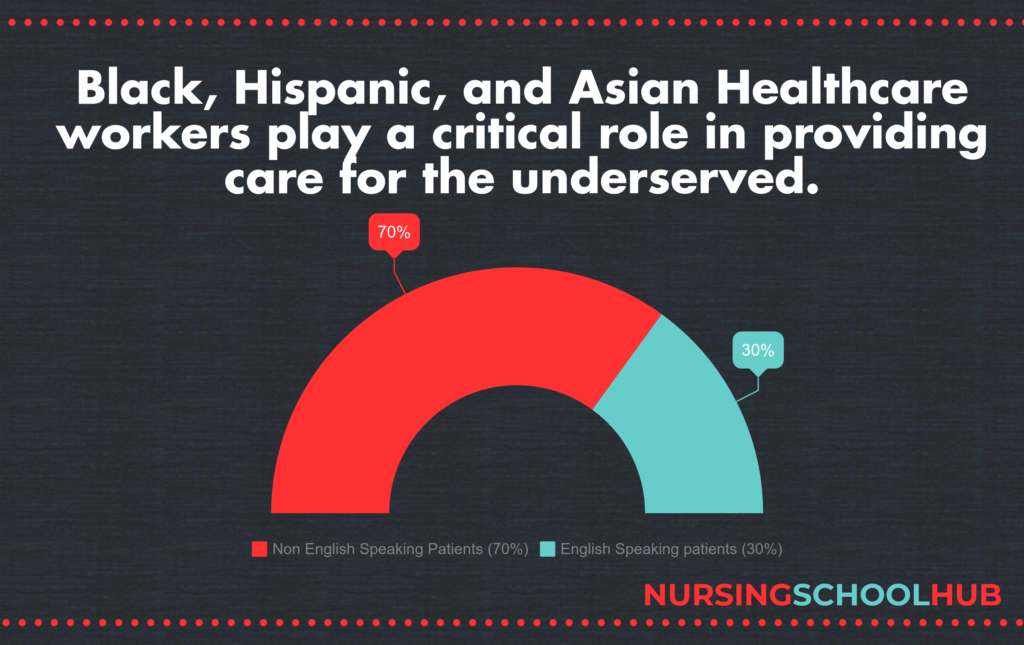
The familiarity offered by someone who looks, sounds, or grew up like the patient can help that patient have an easier time coping with their situation. These aspects can also help to inspire others who may want to pursue a career in the healthcare field. To put it another way, people may not feel they’re right for healthcare because they don’t often see people like themselves in the field.
Diversity Increases Cultural Competence
Diverse nursing professionals help patients feel more comfortable. People who need skilled nursing are often in situations where their comfort ties directly into their convalescence.
In addition, people feel better about discussing their issues with those they perceive as being like them or those who may share some of their backgrounds. A nurse who shares something in common with a patient automatically gives that patient a high level of comfort.
Diversity creates an increase in cultural competence in nursing. Cultural diversity in healthcare helps to build a bond with those who aren’t always fully represented. For this reason, minorities in nursing become extremely important.
What Does Cultural Competence in Nursing Mean?
Cultural competence has a broad definition, but generally, it means having providers who can deliver needed healthcare across social and cultural barriers. Minorities in nursing help with this a great deal. This is especially important because many minority groups have specific or unique traits and pathological features.
Achieving cultural diversity in healthcare is also important for the healthcare field in general. Cultural diversity in healthcare allows different kinds of people from different backgrounds to bring their unique views and understandings to areas of the field that needs them. No one person can know everything. Diversity ensures that knowledge and insight from different areas can help to influence a diagnosis or treatment plan.
Where one nurse may come across a patient with an ailment they have never seen before, another nurse may have intimate familiarity with it because of where they’re from and what they personally experienced. Diversity in nursing helps to bring all these things to the table, strengthening the nursing and healthcare field even more.
Altogether, cultural diversity in nursing practice improves healthcare for everyone involved. This applies to any level of nursing. An influx of unique perspectives contributes to the overall health of all. Equality and diversity in nursing care are worthy goals, and all healthcare providers should put consideration into achieving them.
What Kinds of People are Represented in Nursing?
Nursing is already a highly diverse field in many ways, but the numbers show it’s not as diverse as it probably should be. Different studies show numbers that don’t always match each other, but they all paint a similar picture. In general, the breakdown of those represented in nursing looks a little like this:
AMN Study
- Women in nursing – 89%
- ‘Men in nursing – 10%
- Third gender nurses – 0.1%
- US DoL Registered Nurse Demographics
- Women RNs – 92.1%
- White RNs – 81.9%
- Black RNs – 9.9%
- Asian RNs – 7%
- Hispanic RNs – 3.9%
Underrepresentation
Other sources report similar statistics regarding representation. One thing becomes clear from all these reports, which is a large amount of underrepresentation. Black nurses, Native American nurses, Hispanic nurses, men nurses, and various other groups simply aren’t as prevalent in the nursing field as they should be. This is especially true of advanced practice nursing and higher positions, including many of the best-paying careers in nursing.
Over time, the numbers have grown in some ways but shrank in others. A site that specifically charts minority nurses statistics shows a current demographic spread of:
- 75.4% White nurses
- 23.6% Black nurses or African American nurses
- 7.5% Hispanic nurses
- 3.6% Asian nurses
- 0.6% Native American nurses
That underrepresentation still remains. One of the reasons for the discrepancies is the fact that many minority groups face particular challenges when it comes to entering and maintaining their positions in the nursing field. These challenges can vary between groups. Native American nursing challenges won’t look the same as those faced by African American nurses.
For example, Native American nurses who live on reservations may have limited career options; if they want to work on the reservation, there are few jobs available, but working outside the reservation poses challenges such as commuting. Native American nursing programs may not allow them to practice nursing elsewhere.
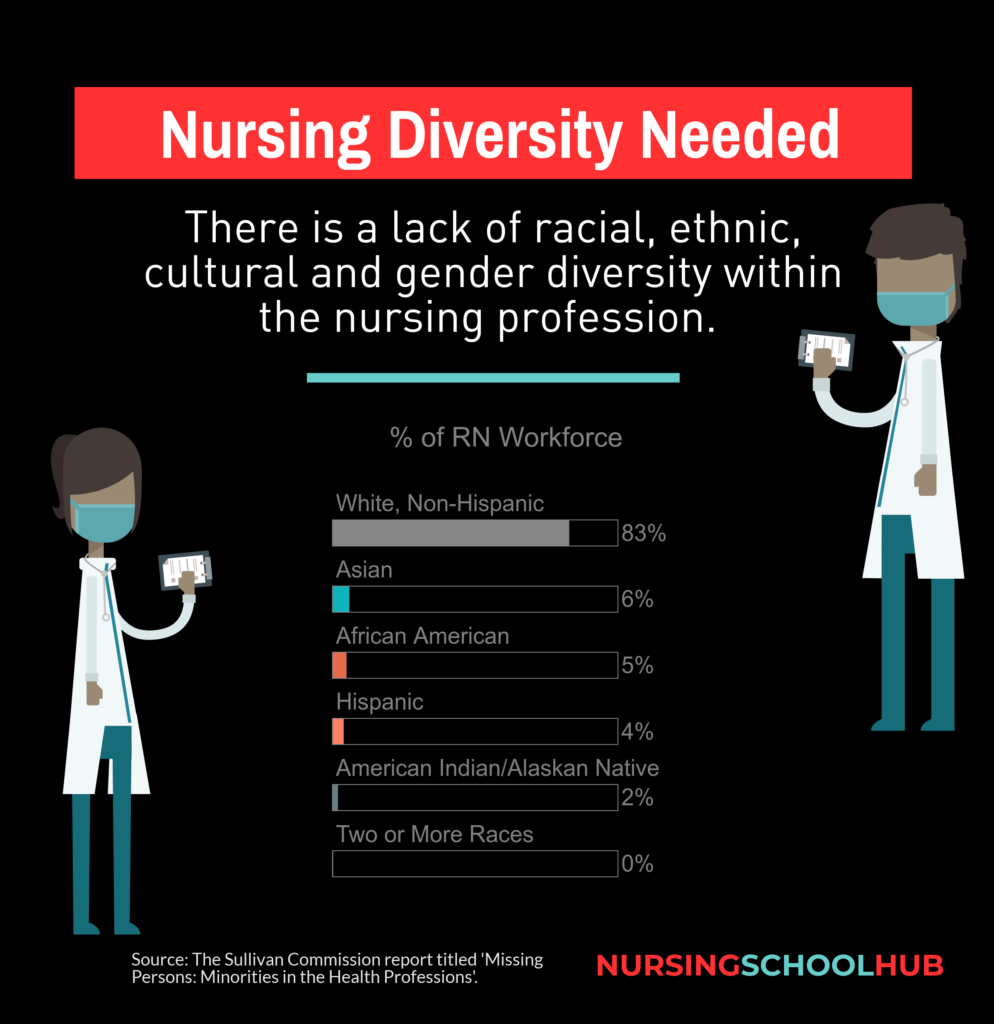
Challenges from Underrepresentation
Underrepresentation leads to unique challenges. Consider that a white woman will see the nursing field populated by a broad spectrum of people she can recognize and identify with. A Hispanic woman may not see that. This can lead to a psychological hurdle that makes it harder for that person to pursue or advance in a nursing career.
In addition, adequate nursing programs may not exist in many minority communities. Various other hurdles can plague the desire of some to join the nursing field, and whole studies are out there exploring those hurdles and solutions for them.
What Steps Are Required to Become a Nurse
Ideally, the steps towards becoming a nurse should follow the same path for everyone. The process can vary depending on the state an applicant lives in and the desired type of nursing position that person wants.
When speaking about diversity in nursing, the position referred to most is that of an RN or registered nurse. While there are nursing positions that exist at a pre-RN level, most conversations involving nursing have to do with those who have obtained the RN position or a later type of nursing designation such as LPN or NP.
Certified Nursing Assistant
A certified nursing assistant position can also apply, as the struggle for diversity exists at that level as well. For example, a minority may have a much harder time going from being a CNA to an RN than someone else in the country. In addition, nursing contains a huge number of specialties.
To start with, someone who desires to become a nurse must start by picking a nursing path. It’s not just about being a nurse, it’s also about where someone wants to be a nurse and in what capacity.
A nurse in a hospital will have different requirements than a nurse in special needs or special care home. Equally, a nurse in a rural area can have different requirements than a nurse in a more urban environment.
Basically, anyone who wants to become nurse will have to put some consideration into whether nursing is really the occupation they want to pursue. Once they’re sure, that person will need to choose a school or program to help them earn their nursing degree.
Note that a degree isn’t always necessary for entry-level nursing. However, a degree is almost always necessary to become an RN. Many short programs can help someone become a CNA as that position usually only requires a high school diploma and some training.
Licensed Practical Nurse
If a student is in a program for LPN or RN status, they often already have everything required to become a CNA, including the information they need to take the appropriate exam. Often, it’s possible to work as a CNA while pursuing the LPN or RN designation.
The LPN, or licensed practical nurse, is typically obtainable through an accredited nursing program. In many parts of the country, it’s possible to become an LPN through training and testing. An applicant would have to make certain they’re in an approved LPN program that trains them towards the taking of an NCLEX exam.
Training and passing the exam will allow someone to apply for a nursing license in their state. People who pursue an Associate Degree in Nursing will often have the opportunity to pursue nursing at anywhere from the CAN to LPN level.
Registered Nurse
When pursuing the RN status, then the applicant must obtain either an associate or bachelor’s in nursing. Unlike other nursing positions that come before the RN level, the requirements for becoming an RN are far more stringent. Applicants will have to take courses at an approved and accredited nursing school or program.
For those who already have another nursing designation, it is sometimes possible to find transition programs to help make the process a little easier. For example. There are LPN to RN programs and other similar courses. Nevertheless, those who want to take up nursing should start off with the expectation that they’ll need to pursue their BSN. Many places make having a BSN a requirement for nursing in their requirements.
Schooling can also come with a requirement for clinicals and other processes that people must go through to earn their degree. The school should also prepare prospective nurses to take the right exam to earn their license. It’s also possible to pursue a nursing specialty while in school.
State Licensing
The major thing to keep in mind is that this process can have slightly different rules depending on the state someone lives in. For minorities and other diverse individuals who want to join or advance their nursing careers, it is imperative to learn how the process works in their particular locales.
Diversity in nursing also requires knowledge of how the nursing career works in any given place. One of the barriers to entry or advancement is a lack of knowledge or the lack of resources needed to obtain that knowledge. This idea is especially important for those who want to advance in a field that is dominated by one type of person.
What Are Some Barriers to Diversity in Nursing?
The nursing field comes with a large number of barriers. Someone arming themselves with knowledge of the process can help to lessen the burden of many of those barriers. In some cases, people need to go out of their way to learn the things they need to learn, especially if they’re in a situation where those answers aren’t easily available to them.
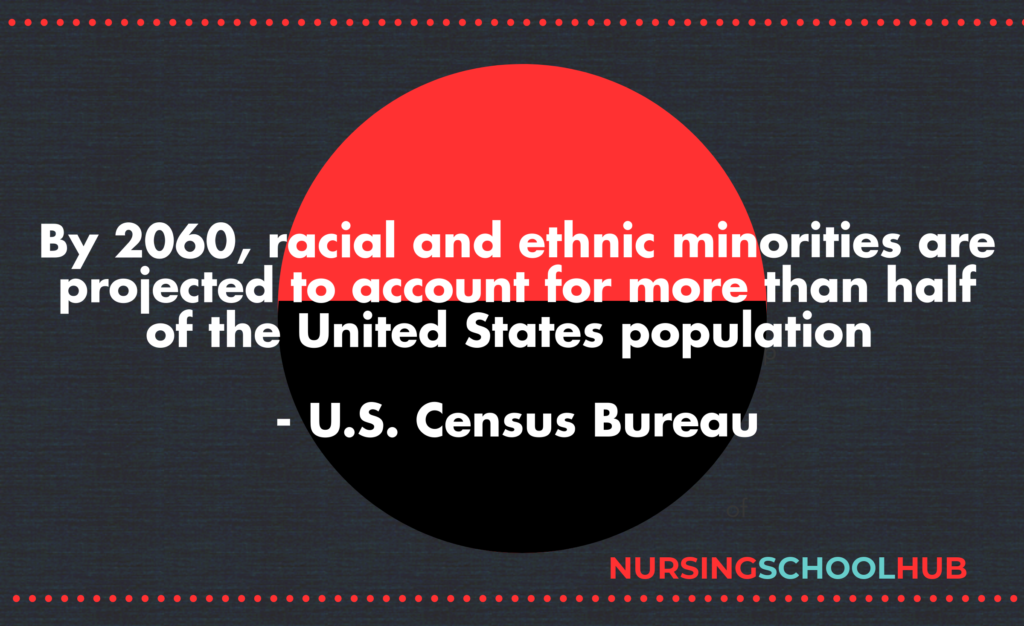
The barriers to diversity in nursing vary but are ever-present. In some cases, people can face multiple barriers, which can make a desire to enter the nursing field that much more of a challenge.
Even for those who do achieve a nursing position, barriers exist that can hold them back from leadership roles, better positions, and other avenues of advancement. Once again, the underrepresentation of minorities in nursing creates some of barriers, but there are other things as well that can keep the field from enhancing diversity in the nursing workforce.
What Barriers do Nurses Face?
Financial considerations are a large barrier for many minorities and one reason why there is a lack of diversity in nursing. Many in minority communities may simply not have the funds for certain types of training. This can become especially true of any type of advanced training classes, which can grow in expense.
One way to overcome financial barriers is to find more information concerning funding and aid. For example, scholarships for minority nurses in one way of increasing diversity in nursing. Some programs do exist to help with finances, but these programs aren’t always readily advertised in minority communities, leaving many people to have to figure things out on their own.
Top 30 National Nursing Scholarships
10 Best Scholarships for Male Nurses
15 Best Scholarships for Minority Nurses
Discrimination in Professional Nursing
Outright discrimination is one of the more negative barriers to diversity in nursing. Discrimination exists at many social levels, and the nursing field is no stranger to it. Someone with an accent or someone who isn’t representative of the majority can become an isolated outcast in the field through no fault of their own.
In some cases, people must contend with discriminatory hiring practices and a lack of advancement because of discrimination. While this sort of discrimination is illegal in the United States, many minority applicants are also afraid to speak out against discrimination, because of the fear of being labeled a troublemaker or unhireable.
What Are Some Examples of Cultural Barriers?
Some cultural barriers can prevent someone from achieving more in the nursing field. Many minority families may stress work over education in order to provide. This can leave someone with a desire to do more, but with the fear of disappointing family members holding them back. A lack of support can easily dissuade anyone from pursuing higher education or better positions in the nursing field.
Many other barriers to diversity in nursing exist. While solutions exist for some concerns, the healthcare industry can do more to level the playing field for minorities and others who want to join the field. The good news is the healthcare industry is doing what it can to attract more diverse people, but there’s still a lot of work to be done.
Why Do We Need More Men in Nursing?
Men also represent a nursing minority. Regardless of culture or background, men are definitely grossly underrepresented in nursing. Many factors contribute to that underrepresentation. The healthcare industry recognizes the need for more men in nursing but men, even men who really want to enter the nursing field, face a tremendous number of barriers.
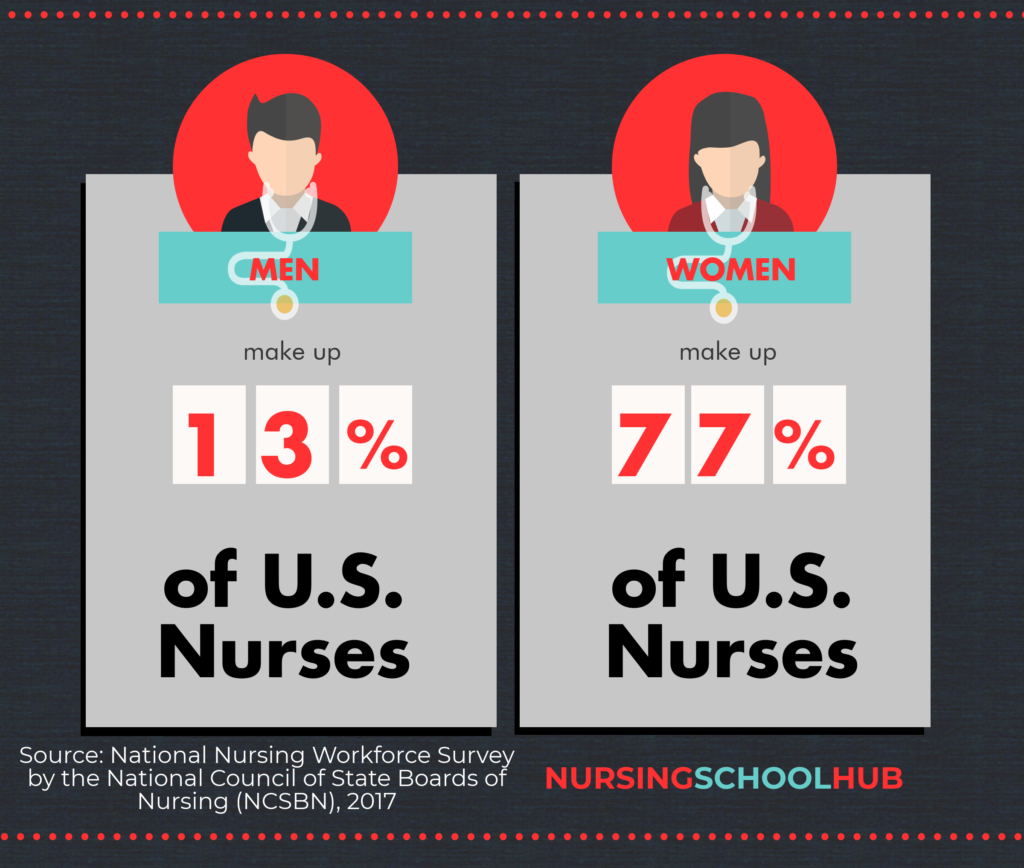
Gender Inequality in Nursing
There’s a very real and somewhat odd type of gender inequality in nursing. Nursing, as a skill, doesn’t come with any type of gender-related expertise. A nurse of any gender can do the same work at the same pace and with the same skill as any other nurse. Yet, despite this, and even though men represent only a tiny part of the nursing field, men still typically earn a higher salary.
Male nurse salary vs female includes a pay gap in the thousands of dollars. Not only does this seem patently unfair, but it can also create issues of male nurses discrimination that only exists because of the male nursing salary. At every level of nursing, men receive higher pay.
Even with equal education and experience, the male nursing salary will outstrip a female’s. While the industry needs more men in nursing, it must also deal with gender inequality in nursing that has to do with this gender pay gap in nursing.
Male Nursing Stereotypes and Stigmas
Another barrier to male nursing comes with the male nursing stereotypes and the associated stigmas. Because the field has a majority female demographic, most people have an assumption that only females can or should become nurses. This notion creates a lot of male nursing stereotypes that many men would rather not deal with. The percentage of male nurses vs female is quite substantial, but the fact that there are around 10% of men in the field should give other men hope.
There’s nothing inherently feminine about nursing. The field exists to help people, and helping people is something anyone with a desire to do should be able to do without fear of male nurses discrimination or derision. Just like with other groups, the nursing field needs men. Male patients can respond better to other men as they may feel another man can better understand what they’re going through.
Using the Term “Male Nurse”
In addition, male nurses tend to love their jobs. On the opposite end of the discrimination, many male nurses gain respect for what they do, especially because they’re men in a field where men aren’t often seen. Even using the term “male nurse” helps to propagate the idea that there’s a gender divide. A nurse is a nurse, and gender has nothing at all to do with the occupation.
The male vs female nurses statistics are not changing drastically, but they are changing. The stigmas and stereotypes of the past are fading, and more men are taking up the call to help those in need. Organizations dedicated to male nursing exist as well, such as the American Assembly for Men in Nursing.
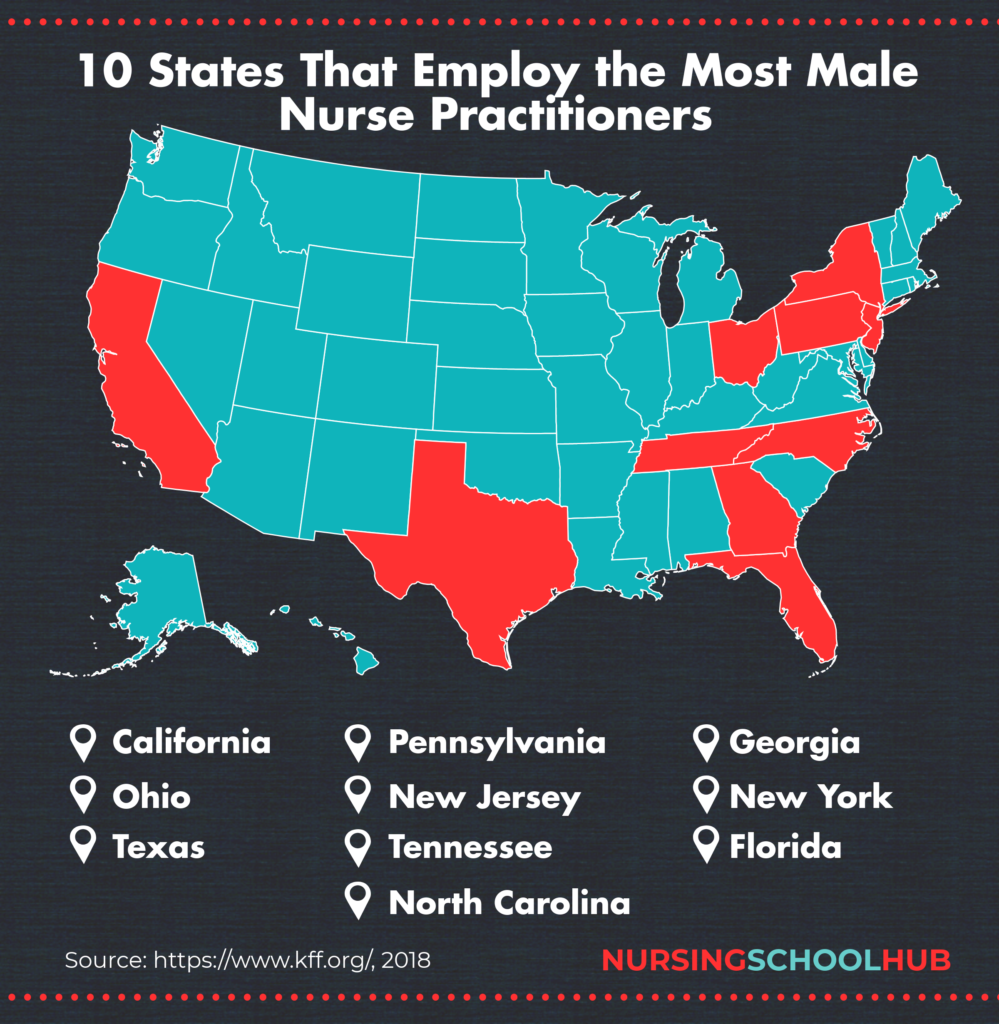
What Are Some Organizations Working for Diversity in Nursing?
Achieving diversity in the healthcare field, and the nursing field specifically, requires an effort from everybody. Many organizations are working hard to make nursing more inclusive and more accessible to everyone.
Some groups or associations focus on a particular culture or locale, while some others focus on removing barriers for multiple groups. The concerted efforts of all these organizations are helping diversity gain ground, which is important as the demographics of the entire country continue to shift.
These organizations often sponsor events, drives, and programs geared toward improving the diversity of the nursing field. They’re also very good resources for people who want to know how they can get their start in nursing or advance in the profession.
Many Ethnic Groups in Nursing
Many ethnic groups exist, so people of a particular culture can look out for nursing organizations with information that applies to someone of a specific culture or background.
Some examples include:
- National Black Nurses Association (NBNA)
- National Association of Hispanic Nurses (NAHN)
- Black Nurses Rock
- The National Coalition of Ethnic Minority Nurse Associations (NCEMNA)
- National Alaska Native American Indian Nurses Association, Inc. (NANAINA)
Many other minority nurses association groups exist as well. In fact, diverse people can look also to local, state, national, and even international organizations as well.
A group like Black Nurses Rock can serve a particular demographic, but it is not the only resource for a black person in the country. This is an important thing to keep in mind. People should seek as many opportunities as they can, and not assume there are only one or two resources available to them.
Benefits of Diverse Nursing Organizations
These nursing organizations are beneficial in a tremendous number of ways. They offer a wide variety of resources, including information, job listings, scholarship opportunities, financial aid, and various other things that can help someone pursue a nursing career.
These groups can also help with education by partnering with like-minded schools and programs. For example, a Black American can search the National Black Nurses Association for opportunities that include HBCUs with nursing programs or HBCU nursing colleges, as many historically black colleges, have a vested interest in taking in those who want to pursue HBCU nursing.
These groups are putting forth a large effort to help add diversity to nursing. Seeing what they’re all about can represent the first step toward someone entering or advancing in the nursing field.
Related: